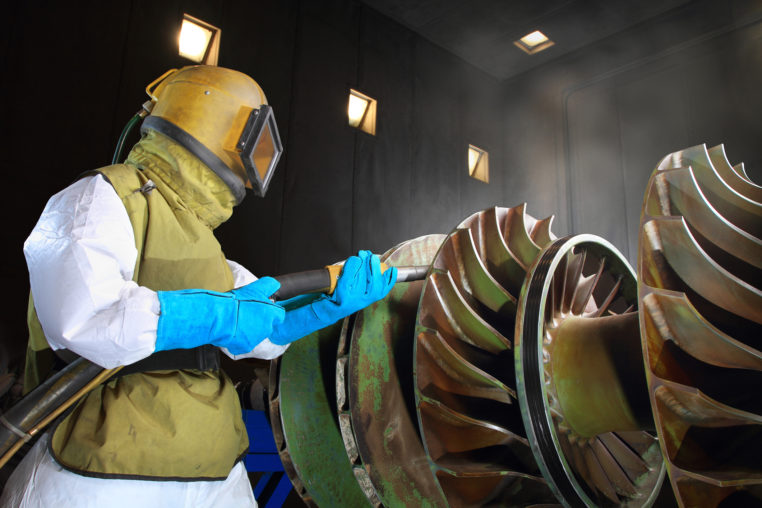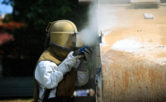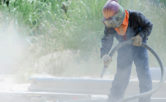
Blasting Media 101: Different Types of Blasting Media
Media blasting is a process using compressed air to blast the surface of the project with various types of gritty substances (called media). This process is done to remove contaminants or create etching, and to prepare the surface for powder coating.
Different media are used for different purposes, and understanding the various types is helpful when approaching your project. Here is a look at the different types of blasting media.
What is Media Blasting?
Media blasting, also known as sandblasting, is a process of propelling abrasive media at a surface to remove contaminants, paint, coatings, or other substances. It is also used to prepare a surface for powder coating, in addition to etching a surface, creating artistic designs or graphics as required by the project. Various different types of media are used depending on the project, the surface, and the desired effects.
What Are The Benefits of Media Blasting?
- Surface Preparation: Media blasting is an effective way to remove rust, scale, paint and other contaminants from a surface. This prepares the surface for painting, priming, welding, or other operations.
- Thorough Cleaning: Media blasting quickly and thoroughly removes surface contaminants without damaging the underlying substrate.
- Improved Appearance: Media blasting can restore a surface to a uniform, attractive appearance.
- Economical: Media blasting can be used on a variety of surfaces and is cost-effective.
- Environmentally Friendly: Media blasting is a non-toxic, non-destructive method of surface preparation. It does not produce hazardous waste or emissions.
Let’s take a look at the different types of blasting media used to create or etch the perfect surface for your next project.
Different Types of Blasting Media
Aluminum Oxide
This is the most common abrasive substance used for blast finishing and surface preparation. Aluminum oxide is exceptionally sharp and long-lasting. One of its biggest advantages is that it is hearty and can be recycled for many repeat uses. It is available in a variety of hardness ratings and grit sizes to tackle numerous types of projects.
Crushed Glass
With its jagged edges and angular profile, crushed glass is an aggressive treatment used to remove heavy coatings and contamination on the surface. The materials used are non-toxic and inert, rendering them completely safe. Additionally, they contain no heavy metals or free silica. Since it is so light, much less of the material is used to prepare the surface—as little as half the material is required versus various other media.
Glass Beads
Glass beads, like crushed glass, used in this form of blasting are safe, non-toxic, and contain no heavy metals or silica. The pre-formed ball shapes polish while they blast, leaving a bright and smooth surface when the blasting process is complete. These materials can also be reused and recycled a number of times.
Plastic Blasting Media
Plastics are ideal for quick stripping and perform with predictable and standardized outputs. When paint needs to be stripped from delicate metals, plastics, automotive surfaces, aerospace materials, or composites, plastics are often the perfect choice.
Silicon Carbide
The hardest of all the blasting media, silicon carbide cuts extremely quickly. It begins as a series of small blocks, which quickly splinter during the blasting process. It can be reused many times. In fact, it is the most recyclable of all the blasting media. It is frequently used for etching stone and glass. It is especially effective when used on surfaces that have heavy rust.
Pumice
The same material sold in blocks to help remove calluses from skin is also a great medium for light blasting jobs. The soft, gritty volcanic stone is ideal for projects requiring delicacy. If the operation requires a dainty touch or a fragile approach to protect the underlying surface material, pumice may be the ideal blasting medium.
Steel Shot
When you need to clean and strip a metal surface, steel shot is the way to go. This material is a series of small steel balls that are fired at the surface to remove materials. This medium leaves the surface with a high polish and shine.
Steel Grit
If the operation requires a very aggressive approach, and if the surface material can withstand this type of blasting, steel grit works quickly. It also removes a wide variety of contaminants. It is perfect for etching metal.
Organic Compounds
Organic materials like corn cobs and walnut shells are environmentally friendly and excellent for protecting underlying surfaces. Corn cob is used in more delicate and soft blasting, such as wood surfaces, whereas walnut shells are implemented in more aggressive stripping.
How Do I Choose The Correct Blasting Media for my Project
The online world is an excellent place to begin your journey. Thousands of different websites are out there to inform you on all of the different media and their characteristics, including hardness and density, the correct surface each works best on, and where to order these materials.
However, to ensure your project is processed with the ideal blasting media, reach out to experts in powder coating who can help you make the best determination.
Get Expert Media Blasting in Las Vegas & Henderson
If you require media blasting in the Las Vegas or Henderson area, AR Powder Coating combines decades of powder coating expertise with top-notch customer service so that your project receives the attention it deserves. Feel free to contact us for more information today!




